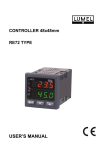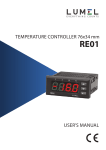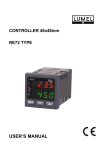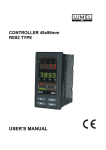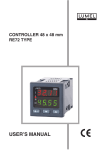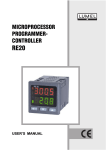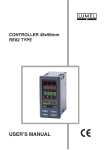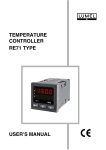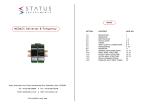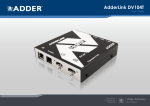Download USER'S MANUAL
Transcript
TEMPERATURE CONTROLLER 48 x 48 mm RE70 TYPE USER’S MANUAL 1 RE70-09 User's Manual 2 Contents: 1. Application ........................................................................................................................ 3 2. Controller set .................................................................................................................... 3 3. Basic requirements, operational safety.......................................................................... 3 4. Installation......................................................................................................................... 4 4.1. Controller installation ................................................................................................... 4 4.2. Electrical connections.................................................................................................. 4 4.3. Recommendations for installation ............................................................................... 5 5. Starting work..................................................................................................................... 6 6. Service ............................................................................................................................... 7 6.1. Programming Controller Parameters ........................................................................... 7 6.2. Programming matrix .................................................................................................... 8 6.3. Setting Change............................................................................................................ 8 6.4. Parameters description ............................................................................................... 8 7. Inputs and outputs of the controller ............................................................................. 10 7.1. Inputs ........................................................................................................................ 10 7.1. Output ....................................................................................................................... 11 8. Control ............................................................................................................................. 11 7.1. ON-OFF algorithm ..................................................................................................... 11 7.2. Innovative SMART PID algorithm .............................................................................. 12 9. Alarms ............................................................................................................................. 14 10. Additional functions ..................................................................................................... 14 10.1. Displaying the control signal .................................................................................... 14 10.2. Manual mode........................................................................................................... 14 10.3. Defaults Settings ..................................................................................................... 15 11. RS-485 interface with MODBUS protocol ................................................................... 15 11.1. Introduction.............................................................................................................. 15 11.2. Error codes .............................................................................................................. 15 11.3. Register map ........................................................................................................... 15 12. Error signaling .............................................................................................................. 17 13. Technical data............................................................................................................... 18 14. Controller ordering code.............................................................................................. 19 RE70-09 User's Manual 3 1. Application The RE70 controller is destined for the temperature control. Controller works directly with the resistance sensors or thermoelectric sensors. The controller is equipped with one output that allows for dual-point control and alert signalization. Dual-point control is based on the PID or ON/OFF algorithm. Relay output is equipped with a switchable contact and allows for indirect control of the low-power objects. The innovative SMART PID algorithm has been implemented in the controller. 2. Controller set 2 1 3 4 12 34 OU T SP ST RE 70 5 Complete set of the controller includes: 1. controller ................................................ 1 pc 2. plug with 6 screw terminals .................... 1 pc 3. plug with 8 screw terminals .................... 1 pc 4. holders to fix the meter in the panel ....... 4 pcs 5. seal ........................................................ 1 pc 6. user’s manual ........................................ 1 pc 7. guarantee card....................................... 1 pc 3. Basic requirements, operational safety In terms of operational safety the controller meets the requirements of the EN 61010-1 standard. Comments concerning safety: • Assembly and installation of the electrical connections should conducted only by people authorised to perform assembly of electric devices. • Always check the state of connections before turning the controller on. • Prior to taking the controller housing off, always turn the supply off and disconnect measuring circuits. • Removal of the controller housing during the warranty period voids the warranty. • The device is designed to installation and usage in the industrial electromagnetic environment. • The installation should have a switch or a circuit-breaker installed. This switch should be located near the device, easy accessible by the operator and suitably marked. RE70-09 User's Manual 4 4. Installation 4.1. Controller installation Fix the controller to the board with four screw brackets as shown in the fig. 1. A slot in the panel must have the dimensions 45+0,6 x 45+0,6 mm. The thickness of the panel material cannot exceed 15 mm. 1 2 Fig. 1. Controller installation. Dimensions of the controller are presented on the fig. 2. max. 93 8 70 48 48 max.15 Fig. 2. Controller dimensions. 4.2. Electrical connections The controller has two separate connectors with screw terminals. One strip enables the connection of the supply and outputs by a wire of 2,5 mm2, the second strip enables input signal connections by a wire of 1,5 mm2. RE70-09 User's Manual 5 Fig. 3. View of the controller's connection strips. Pt1000 5 4 3 thermoresistor Pt100 thermoresistor Pt100 thermoresistor in 2-wire system in 3-wire system Pt1000 Fig. 4. Input signals 13 14 + Pt100 5 4 3 - Pt100 5 4 3 2 1 thermocouple supply Fig. 5. Supply 9 10 11 load supply Fig. 6. Control/Alarm output B (-) 8 A(+) 7 Fig. 7. RS-485 interface (only for configuration) 4.3. Recommendations for installation To achieve full electromagnetic resistance of the controller, it is necessary to follow the rules described below: do not supply the controller from the network in the proximity of devices generating high pulse noises and do not apply common earthing circuits, apply network filters, wires leading measuring signals should be twisted in pairs, and for resistance sensors in 3-wire connection, twisted of wires of the same length, cross-section and resistance, and led in a shield, all shields should be one-side earthed or connected to the protection wire, the nearest possible to the controller, RE70-09 User's Manual 6 as a rule of thumb, wires transmitting different signals should be spaced as far as it is possible (at least 30 cm) and should be crossed only at the right angle of 90°. 5. Starting work Controller description display for measured value, set point, menu active output indicator self-tune indicator manual mode indicator display set point indicator keys Fig. 8. Overview of the controller's front panel. Switching a supply on After powering on, the controller performs the display test, displays r e 7 0 text, software version and the measured value. Display may also show an error message (see table 11). The ON-OFF control algorithm with hysteresis given in the table 2 is set by the defaults. Change of the set point Set point is displayed after ? or > buttons are pressed, this is accompanied by SP diode switching on. To change the set point, press ? or > buttons again (fig. 9). The beginning of the change is signaled by pulsing dot symbol on the display. New set point must be accepted with a @ button within 30 seconds after the ? or > button have been pressed, otherwise regulator will display set point with previously set point. measured value or accept new set-point set-point change indicator to change set-point press and hold one of the button Fig. 9. Change value of the set point. RE70-09 User's Manual 7 6. Service The controller service is presented on the fig. 10. change set point mode normal working mode to change press or measured value display control signal set point to accept press to cancel press + h___ 2sec. + manual mode 2 sec. + active access code tune press and hold to decrease the value self-tune mode press and hold to increase the value code Y N 2sec. Y correct code? locking of change N err 3sec. + parameter programming mode Fig. 10. Menu of controller service 6.1. Programming Controller Parameters Pressing and holding down during ca 2 seconds the button @ causes the entry to the programming matrix. The programming matrix can be protected by an access code. In case when giving a wrong value of the code, it is only possible to see settings through - without possibility of changes. Fig. 11 presents the transition matrix in the programming mode. The transition between levels is carrying out by using the buttons ? or > and the level selection by using the button @ . After selecting the level, the transition between parameters is carried out by using the buttons ? or > . In order to change the parameter setting proceed acc. to the section 6.3. In order to exit from the selected level, transit between parameters until appears the symbol [. . .] and press the button @ . In order to exit from the programming matrix to the normal working mode, transit between levels until appears the symbol [. . .] and press the button @ . Some controller parameters can be invisible – it depends on the current configuration. The description of parameters shows the table 1. The return to the normal working mode follows automatically after 30 seconds since the last button pressure. RE70-09 User's Manual 8 6.2. Programming matrix inp unit Input parameters iNty Unit Input type outp out ... Output parameters Output configuration Transition to the higher level ctrl alg type sHif dp ... Type of line Shift of measured value Position of decimal point Transition to the higher level Hy sTlo sTHi ... Type of control Hysteresis Lower threshold for self-tuning Upper threshold for self-tuning Transition to the higher level ti td y0 to ... Integral time constant Derivative time constant Correction of control signal, for P or PD control Pulse period Transition to the higher level aLsp aLdu aLHy ... Set point for the absolute alarm Deviation from the set point of the relative alarm Alarm hysteresis Transition to the higher level Control parameters Control algorithm pid pb PID Parameters Proportional band alar Alarms parameters t-li spp spl spH ... Set point parameters lower limitation of the set point setting upper limitation of the set point setting Transition to the higher level seru seCU sTfn ... Service parameters Access code Self-tuning function Transition to the higher level ... Exit from the menu Fig. 11. Programming matrix 6.3. Setting Change The change of parameter setting begins after pressing the button @ during the display of the parameter name. The setting selection is carried out through the buttons ? and > and accepted by the button @ . The change cancellation follows after the simultaneous pressure of the buttons ? and > or after 30 seconds since the last button pressure. The way to change the setting is shown on the fig. 12. + to change press 1234 decrement value + cancel to change press accept new value increment value oNof previous text value next text value Fig. 12. Setting change of number and text parameters. 6.4. Parameters description The list of parameters is presented in the table 1. cancel accept new value RE70-09 User's Manual 9 List of configuration parameters Symbol of parameter Parameter description Table 1 Default setting Range of parameter change i n p – Input parameters unit Unit qC q C : degrees Celsius q f : degrees Fahrenheit p t 1: Pt100 p t 1 0: Pt1000 t - ,: J type thermocouple iNty t - t: T type thermocouple Input type pt1 t - k: K type thermocouple t - s: S type thermocouple t - r: R type thermocouple t - b: B type thermocouple t - n: N type thermocouple t-li Line type for the sensor Pt100 dp Position of the decimal point 1-dp shif Shift of measured value 0.0 °C (0.0 °F) 2-p 2 - p: 2-wire 3 - p: 3-wire 0 _ d p: without a decimal place 1 _ d p: 1 decimal place -100.0…100.0 °C (-180.0…180.0 ) o u t p – Output parameters o f f: control off Y: control signal A H i: upper absolute alarm out Output configuration y A l o: lower absolute alarm d w H i: upper relative alarm d w l o: lower relative alarm d w i n: internal relative alarm d w o u: external relative alarm c t r l – Control parameters 1) alg Control algorithm type Type of control Hy Hysteresis 4) sTlo sTHi Lower threshold for self-tuning Upper threshold for self-tuning oNof inu 2.0 °C (3.6 °F) 0.0 °C (32.0 °F) 800.0 °C (1,472.0 °F) o N o f: ON-OFF control algorithm p i d: PID control algorithm d i r: direct control (cooling) i n u: reverse control (heating) 0.2…100.0 °C (0.2…180.0 °F) MIN…MAX 6) MIN…MAX 6) p i d – PID parameters 2) pb Proportional band 30.0 °C (540.0 °F) 0.1…550.0 °C (0.1…990.0 °F) RE70-09 User's Manual Symbol of parameter ti td y0 to Parameter description 10 Default setting Range of parameter change Integral time constant 300 0…9999 s Derivative time constant 60.0 0.0…2500 s Correction of control signal, for P or PD control 0.0 0…100.0 % Pulse period 20.0 0.5…99.9 s a l a r – Alarms parameters 3) aLsp Set point for the absolute alarm aLdu Deviation from the set point of the relative alarm aLHy Hysteresis for the alarm 0.0 °C (32.0 °F) 0.0 °C (0.0 °F) MIN…MAX 6) -200,0… 200,0 °C (-360.0…360.0 °F) 0.2…100.0 °C (0.2…180.0 °F) 2.0 °C (3.6 °F) s p p – Set point parameters spl spH Lower limitation of the set point setting Upper limitation of the set point setting -200.0 °C (-3,280.0 °F) 1,767.0 °C (3,212.6 °F) MIN…MAX 6) MIN…MAX 6) s e r p – Service parameters seCU sTfn Access code 5) 0 on Self-tuning function 0…9999 o f f: locked o n: available 1) Group of parameters visible only when setting the output on the control signal. Group of parameters visible only when setting the control algorithm on PID. 3) Group of parameters visible only when setting the output on one of the alarm. 4) Parameter visible only when setting the control algorithm on ON-OFF. 5) Parameter hidden in the monitoring mode of parameters only for readout. 6) See table 2. 2) Range limits for inputs Input / sensor Thermoresistor Pt100 Thermoresistor Pt1000 J type thermocouple T type thermocouple K type thermocouple S type thermocouple R type thermocouple B type thermocouple N type thermocouple table 2 MIN °C -200 °C -200 °C -50 °C -50 °C -50 °C 0 °C 0 °C 0 °C -50 °C MAX °F -328 °F -328 °F -58 °F -58 °F -58 °F 32 °F 32 °F 32 °F -58 °F °C 850 °C 850 °C 1,200 °C 400 °C 1,372 °C 1,767 °C 1,767 °C 1,767 °C 1,300 °C °F 1,562 °F 1,562 °F 2,192 °F 752 °F 2,501.6 °F 3,212.6 °F 3,212.6 °F 3,212.6 °F 2,372 °F 7. Inputs and outputs of the controller 7.1. Inputs Input is the source of the measured value used for control or for alarms. The input is universal and the sensors Pt100, Pt1000 or thermocouples can be connected to it. RE70-09 User's Manual 11 Start by using a u n i t parameter to set the temperature display unit. Unit change resets the value to the factory settings, with a different value ranges for Celsius and Fahrenheit scale. Input signal is selected with a i N t y parameter. For the Pt100 thermoresistor, choose the t - l i connection type - 2-wire or 3-wire. In the 3-wire Pt100 connection, resistance compensation is automatic. For thermocouples, a cold terminal compensation is automatic. Position of the decimal point is a additional parameter that determines display format of measured value and set point; it is set by the d p parameter. Correction of the indicated measured value is determined by the s h i f parameter. 7.1. Output The controller has one output. It is possible to choose the following output options: on-off control, proportional control (PID) or alert. It is necessary to set the pulse period for the proportional control. Pulse period is a time between two subsequent input engagements during proportional control. Pulse period length should be adjusted for the dynamic properties of the object and characteristics of the output device. It is recommended to use SSR transmitter for quick processes. Relay output is used for a contactor control in the slow-changing processes. Long pulse periods for quick-change processes may cause unnecessary oscillation. In theory, the shorter pulse period is, the better the control, however for the relay output a period should be as large, as possible to optimize lifespan of the relay. Pulse period setting recommendations Output Pulse period is recommended >20s min. 10 s electromagnetic transmitter min. 5 s Table 3 Load 5 A/230 VAC or a contactor 2 A/230 VAC 8. Control 7.1. ON-OFF algorithm When high accuracy of a temperature control is not required, especially for the high time constant and small delay, it is possible to use ON-OFF control with hysteresis. Disadvantage of this method is the occurrence of oscillations, even at small hysteresis values. output hysteresis on off setpoint value measured value Fig. 13. Operation way of the heating type output for the ON-OFF control. RE70-09 User's Manual 12 7.2. Innovative SMART PID algorithm When high precision of the temperature control is necessary, it is recommended to use PID algorithm. Innovative SMART PID algorithm ensures increased precision in the extended range of the control object classes. Tuning of the controller to object is achieved by automatically selected PID parameters using the self-tuning function or manual setting the value of the proportional element, integral element and derivative element. 7.2.1. Self-tuning The controller has the function to select PID settings. In most cases these settings ensure an optimal control. To begin the self-tuning, transit to the t u n e message (acc. to the fig. 10) and hold down the button @ during at least 2 sec. If the control algorithm is set on ON-OFF or the selftuning function is locked, then the tune message t u n e is hidden. For a correct realization of the self-tuning function, it is required to set the parameters s T l o and s T H i . The parameter s T l o should be set on the value corresponding to the measured value at the switched off control. For object temperature control, you can set 0ºC. The parameter s T H i should be set on the value corresponding to the maximum measured value when the control is switched on the full power. The flickering AT symbol informs about the activity of the self-tuning function. The duration of self-tuning depends on dynamic object properties and can last maximally 10 hours. During self-tuning or directly after it, over-regulations can occur and because of this, one must set a smaller set point if possible. The self-tuning is composed of following stages: self-tuning process YES - calculation of PID settings and stored them in the non-volatile memory - start control with new PID settings self-tuning ended with success NO - enter to manual mode - the error code is on the display until confirmation The self-tuning process will be stopped without counting PID settings, if a supply decay occurs or the button @ will be pressed. In this case, the control with current PID settings will be started. If the self-tuning experiment does not end with success, then an error code will be displayed, acc. to the table 4. RE70-09 User's Manual Error codes for self-tuning function Error code Reason eS0 1 P or PD control was selected. eS0 2 The set point is incorrect. eS0 3 The button @ was pressed. The maximal self-tuning duration time has been exceeded. The waiting time of switching has been exceeded. eS0 4 eS0 5 13 Table 4 Procedure One must choose PI, PID control, i.e. the TI unit must be higher than zero. Change temperature set point or the parameters sTlo, sT Hi. Check, if the temperature sensor is correctly situated, if the set point value is not set too higher for the given object. eS0 6 The input range limit has been exceeded. Take note of the way to connect the sensor. Do not allow that the overflow results in exceeding of the input range limit. eS2 0 Very non-linear object, enabling to obtain correct values of PID parameters, or an interference has occurred. Carry out the self-tuning again. If that does not help, choose PID parameters manually. 7.2.2. Proceeding in case of a unsatisfactory PID control It is recommended to choose PID parameters, changing the value in a twice higher or twice less. During the change, one must respect following principles. a) Free jump response: − decrease the proportional band, − decrease the integral and derivative time. b) Over-regulations − increase the proportional band, − increase the derivative time, c) Oscillations − increase the proportional band, − increase integral time, − decrease the derivative time, d) Instability − increase the integral time. RE70-09 User's Manual 14 9. Alarms The controller output can be configured as an alarm output. For this, set the parameter ou t as one of alarms. Available types of alarms are given on the figure 14. aLsp aLsp absolute high absolute lower (o out = AHi) (o out = Alo) a L d u (+) SP SP a L d u (-) relative high relative high (o out = dwHi) (o out = dwHi) aLdu SP SP a L d u (-) relative lower (o out = dwlo) a L d u (+) relative lower aLdu SP SP aLdu relative internal (o out = dwlo) (o out = dwin) Fig.14. Types of alarms aLdu relative external (o out = dwou) The set point for absolute alarms is the value defined by the parameter a L s p , and for relative alarms, it is the deviation from the set point - the parameter a L d u . Alarm hysteresis, the zone around the set point in which the input state is not changed is defined by the a L H y parameter. 10. Additional functions 10.1. Displaying the control signal After pressing the button @ the value of the control signal (0…100%) is displayed on the display. On the first digit the h mark is displayed. Control signal can be displayed when the ou t parameter is set on y . 10.2. Manual mode The manual mode gives the possibility to identify, test the object, or control it after a sensor damage. The entry to the manual mode follows after holding down the button @ during the control signal is display. The manual mode is signaled by the pulsation of the diode with the symbol . The controller interrupts the automatic control and begins the manual mode of the output. The control signal value is on the display, preceded by the symbol h. For the ON-OFF control – the control signal can be set up by the buttons ? or 100%. For the PID control – the control signal can be set up by the buttons ? optional value from the 0.0…100% range. and > and > at 0% at any The exit to the normal work mode follows after pressing simultaneously the buttons ? and > . RE70-09 User's Manual 15 10.3. Defaults Settings Defaults settings can be restored during the supply connection by holding down the buttons ? and > till the moment when the inscription f a b r appears on the display. 11. RS-485 interface with MODBUS protocol 11.1. Introduction RE70 controller is equipped with RS-485 serial interface with implemented MODBUS asynchronous communication protocol. The interface is designed for controller configuration prior to using it. Summary of the RE70 controller serial interface: − device address: 1, − baud rate: 9600 bit/s, − operation modes: RTU, − information unit: 8N2, − data format: integer (16 bits) − maximum response time: 500 ms, − maximum number of registers read/written in one command: 32. RE70 controller uses following protocol functions: Table 5 Code 03 06 16 17 Meaning n-registers read 1 register write n-registers write slave device identification 11.2. Error codes If the controller receives query with the transmission error or checksum error, then such query will be ignored. When a query with correct syntax and invalid values is found, the controller returns an error code. Table 6 shows error codes and their meaning. Error codes Table 6 code meaning reason 01 illegal function function is not handled by the controller 02 illegal data address register address out of range 03 illegal data value register value out of range or register is readout only 11.3. Register map In the controller, data are placed in 16-bit registers. The list of registers for write and readout is presented in the table 7. Operation "R-" – means the possibility of readout, and the operation "RW" means the possibility for readout and write. RE70-09 User's Manual 16 Map of the registers from address 4000 register address operati marking on Table 7 parameter range 4000 -W 1 4001 4002 4003 4004 4005 4006 4007 4008 RRRRRRRR- 100…999 1301…9999 1…9999 0…0xFFFF 0…0xFFFF acc. to the table 10 acc. to the table 10 0…1000 4009 UNIT RW 0…1 4010 INPT RW 0…8 4011 T-LI RW 0…1 4012 DP RW 0…1 4013 SHIF RW -1000…1000 [x10 °C] -1800…1800 [x10 °F] 4014 OUT RW 0…7 4015 ALG RW 0…1 4016 TYPE RW 0…1 4017 HY RW 4018 4019 STLO STHI RW RW 4020 PB RW 4021 4022 TI TD RW RW 2…1000 [x10 °C] 2…1800 [x10 °F] acc. to the table 10 acc. to the table 10 1…5500 [x10 °C] 1…9900 [x10 °F] 0…9999 0…25000 4023 Y0 RW 0…1000 4024 4025 TO ALSP RW RW 5…999 acc. to the table 10 description Command register 1 – revert to defaults settings (except for interface settings and defined programs) Program version number [x100] Older 4 digits of the serial number Younger 4 digits of the serial number Controller status – description in the table 8 Error status – description in the table 9 Measured value PV Current set point SP Control signal [% x10] Unit 0 – degrees Celsius 1 – degrees Fahrenheit Type of main input: 0 – thermoresistor Pt100 1 – thermoresistor Pt1000 2 – J type thermocouple 3 – T type thermocouple 4 – K type thermocouple 5 – S type thermocouple 6 – R type thermocouple 7 – B type thermocouple 8 – N type thermocouple Type of line 0 – 2-wire 1 – 3-wire Position of the decimal point of the main input 0 – without a decimal place 1 – 1 decimal place Shift of the measured value of the main input Output function 0 – no function 1 – control signal 2 – upper absolute alarm 3 – lower absolute alarm 4 – upper relative alarm 5 – lower relative alarm 6 – internal relative alarm 7 – external relative alarm Control algorithm 0 – ON-OFF 1 – PID Type of control 0 – direct control – cooling 1 – reverse control – heating Hysteresis HY Lower threshold for self-tuning Upper threshold for self-tuning Proportional band PB Integral time constant TI [s] Derivative time constant TD [s x10] Correction of control signal Y0 (for P or PD control) [% x10] Pulse period of output [s x10] Set point for the absolute alarm [x10] RE70-09 User's Manual register address marking operati on 4026 ALDV RW 4027 ALHY RW 4028 4029 4030 SPL SPH SECU RW RW RW 2…1000 [x10 °C] 2…1800 [x10 °F] acc. to the table 10 acc. to the table 10 0…9999 4031 STFN RW 0…1 17 parameter range description -1800…1800 [x10 °C] -3600…3600 [x10 °F] Deviation from the set point of the relative alarm Hysteresis for the alarm Lower limitation of the fast set point change Upper limitation of the fast set point change Access code to the menu Self-tuning function 0 – locked 1 – unlocked Register 4002 – controller status bit 0-11 12 13 14 15 Table 8 description Reserved Automatic/Manual mode: 0 – automatic, 1 – manual State of alarm: 0 – active, 1 – inactive Measured value beyond the range limits Controller error – check the error register Register 4003 – error register bit 0-14 15 Table 9 description Reserved Input discalibrated Input range limits sensor type Pt100 Pt1000 Fe-CuNi (J) Cu-CuNi (T) NiCr-NiAl (K) PtRh10-Pt (S) PtRh13-Pt (R) PtRh30-PtRh6 (B) NiCrSi-NiSi (N) Table 10 range UNIT = °C [x10] UNIT = °F [x10] -2000…8500 -2000… …8500 -500… …12000 -500… …4000 -500… …13720 0… …17670 0… …17670 0… …17670 -500… …13000 -3280… …15620 -3280… …15620 -580… …21920 -580… …7520 -580… …25016 320… …32126 320… …32126 320… …32126 -580… …23720 12. Error signaling Character messages signaling the incorrect controller operation. Error code Reason Procedure Table 11 _ _ __ Down overflow of the range limit or lack of RTD Check, if input signal values are situated in the appropriate range – if yes, check if check if there is no short circuit in the thermoresistor or the thermocouple is connected inversely. : : :: Upper overflow of the range limit or break in the sensor circuit Check, if input signal values are situated in the appropriate range – if yes, check if there is no break in the sensor circuit. e R ad Input discalibrated e R ee Configuration parameters checksum error Connect the controller supply again and if that is not effective, contact the nearest service shop. Connect the controller supply again and if that is not effective, contact the nearest service shop. RE70-09 User's Manual 18 13. Technical data Input signals acc. to the table 12 Input signals and range limits for inputs Sensor type 1) *) Table 12 Standard Designation Pt100 EN 60751+A2:1997 Pt100 Pt1000 EN 60751+A2:1997 Pt1000 Fe-CuNi EN 60584-1:1997 J Cu-CuNi EN 60584-1:1997 T NiCr-NiAl EN 60584-1:1997 K PtRh10-Pt EN 60584-1:1997 S PtRh13-Pt EN 60584-1:1997 R PtRh30-PtRh6 EN 60584-1:1997 B NiCrSi-NiSi EN 60584-1:1997 N Range -200…850 °C -328…1,562 °F -50…1200 °C -58…2,192 °F -200…850 °C -328…1,562 °F -50…400 °C -58…752 °F -50…1372 °C -58…2,501.6 °F 0…1767 °C 32…3,212.6 °F 0…1767 °C 0…1767 °C 32…3,212.6 °F 1) -50…1300 °C 32…3212,6 °F 1) -58…2,372 °F Intrinsic error is related to the range limits 200…1,767 °C (392…3,212.6 °F) Sensor line resistance <10 Ω/wire; the connection must use wires of identical diameter and length Basic error of real value measurement 0.3% for thermoresistance inputs 0.3% for thermoelectric inputs (0.5% – for B, R, S); Measurement time 0.33 s Detection of error in the measurement circuit: - thermocouple, Pt100 range limit exceeded Types of outputs: relay output type SPDT (form C), max load: 5 A/230 V AC, max. 200,000 cycles for 5 A/230 V AC (resistive) Way of output operation: - reverse - direct for heating for cooling Rated operating conditions: - supply voltage - supply voltage frequency - ambient temperature - storage temperature - relative air humidity - preheating time - operating position 230 VAC ±10% 50/60 Hz 0…23…50 °C -20…+70 °C < 85% (no condensation) 30 min any Power input < 4 VA Weight < 0.25 kg Protection grade ensured by the housing - from the frontal plate - from the terminal side acc. to EN 60529 IP65 IP20 Additional errors in rated operating conditions caused by: - compensation of reference junction temperature changes ≤ 2°C - resistance change of thermoresistance sensor line ≤ 50% intrinsic error value - ambient temperature change ≤ 100% intrinsic error value /10 K 1) Safety requirements acc. to EN 61010-1 - circuit-to-circuit insulation basic - installation category III - pollution grade 2 - maximum phase-to-earth operating voltage: RE70-09 User's Manual - for supply circuit, output - for input circuits - altitude a.s.l. 19 300 V 50 V below 2000 m Electromagnetic compatibility: - noise immunity, acc. to standard EN 61000-6-2 - noise emission, acc. to standard EN 61000-6-4 14. Controller ordering code The way of coding is given in the table 13. Versions and ordering Table 13 RE70 controller – XX X Version Language version acceptance tests * standard * custom-made Polish English * other without extra quality requirements with quality inspection certificate * according to buyer's specification after agreeing with the manufacturer X 00 XX P E X 0 1 X LUMEL S.A. ul. Słubicka 1, 65-127 Zielona Góra, Poland Export Department: Tel.: (48-68) 45 75 302 Fax: (48-68) 32 54 091 e-mail: [email protected] 92 RE70-09 Tel.: (48-68) 45 75 100 Fax: (48-68) 45 75 508 e-mail:[email protected] http://www.lumel.com.pl




















